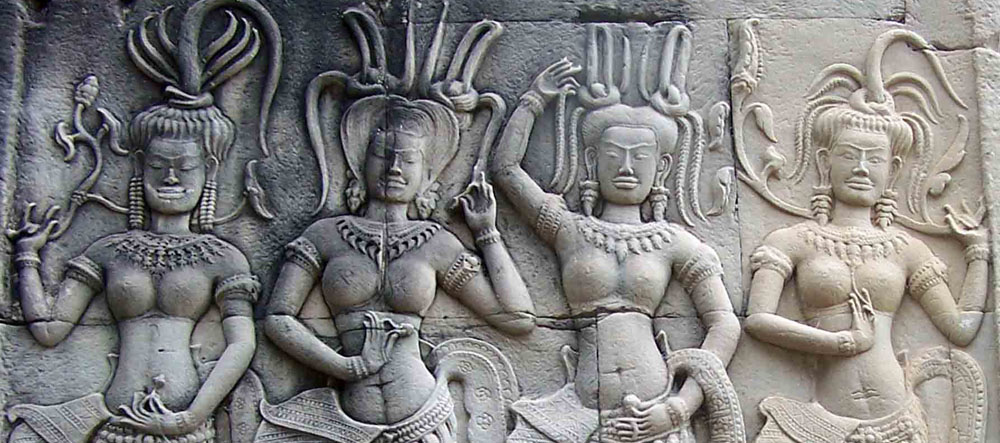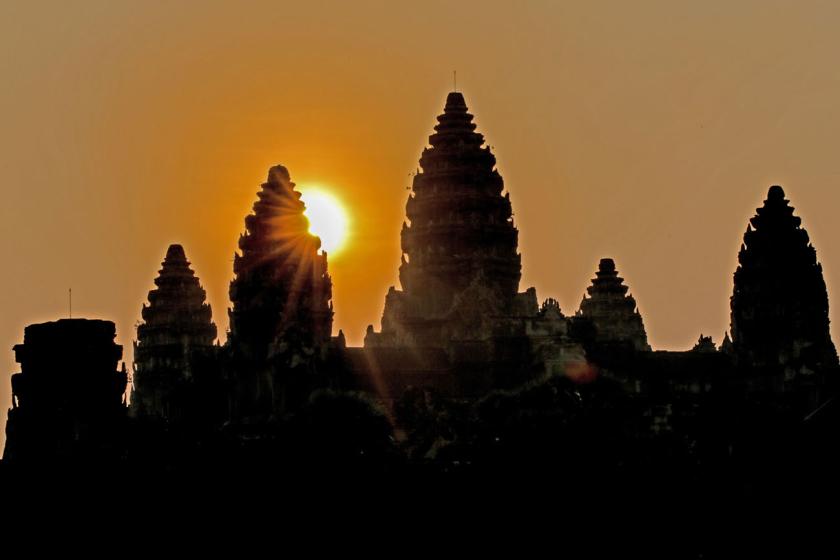Angkor Wat in Cambodia is the biggest religious complex ever built. It is also one of the most beautiful and awe-inspiring structures ever created, even now still a working temple with both Buddhist and Hindu connections. It was at the heart not only of a vast medieval city but an empire that dominated southeast Asia for centuries.
The first instalment of this two-part documentary revealed how Angkor’s mysterious history, its rise and fall, are being slowly unravelled by academics from Hong Kong, Australia, France, America and Cambodia itself. We were shown a new technology, LiDAR, a kind of radar-laser combination that can explore underground and produce maps of long-hidden cities, canals, and roads. From LiDAR’s data come digital reconstructions of the footprints of the vast cities, which, unlike the great temples of sandstone, would have been built of perishable materials – wood and thatch (Aspara carvings at Angkor Wat, below).
 Prosperity was agricultural, and the Khmers’ mastery of irrigation meant moving from one to as many as four rice harvests annually. We visited two huge reservoirs, called baray, built more than half a millennium ago – 200,000 workers were needed for the construction - in a successful attempt to counteract the contrast of the six months of monsoon, when the country floods, followed by six months of dry weather when nothing that is not irrigated can grow.
Prosperity was agricultural, and the Khmers’ mastery of irrigation meant moving from one to as many as four rice harvests annually. We visited two huge reservoirs, called baray, built more than half a millennium ago – 200,000 workers were needed for the construction - in a successful attempt to counteract the contrast of the six months of monsoon, when the country floods, followed by six months of dry weather when nothing that is not irrigated can grow.
In the 12th century, while London had a population of about 18,000, there were three quarters of a million Khmer at Angkor. When the Khmer dominated Southeast Asia, their cities had thousands of homes, with monasteries, palaces, water supplies. We were shown the unprecedented road network which even led to a still extant salt mine in north-west Thailand, salt being an essential ingredient in the fish paste that sustained adequate nutrition in the dry season.
Convincing theories were advanced by Professor Richard Engelhardt of Hong Kong (pictured below) about the achievements of the engineering miracle that is Angkor Wat itself. It is a temple made of sandstone, with no mortar, the precision of its mathematics ensuring it all fitted together. But it has survived in this waterlogged landscape because it sits on laterite, a stone that is an ancient breezeblock; and because in Professor Englehardt’s new theory, the huge moat that surrounds Angkor Wat actually holds the temple together through water pressure. Though Angkor Wat is four times the size of Vatican City, it was built in less than 40 years at a time when a Norman cathedral would take a century.
 It is now visited by two million tourists a year, and the $2bn travel industry that has opened up only in the past two decades or less is now responsible for 20 per cent of Cambodia’s economy: a ritualistic minute or so reminded us with film clips of the horrors of the Khmer Rouge. And we were also reminded that some archaeological investigations were still hampered by the countless unexploded mines in the Kulan Hills, the sites of the earliest Khmer settlements, as yet hardly visited by tourists.
It is now visited by two million tourists a year, and the $2bn travel industry that has opened up only in the past two decades or less is now responsible for 20 per cent of Cambodia’s economy: a ritualistic minute or so reminded us with film clips of the horrors of the Khmer Rouge. And we were also reminded that some archaeological investigations were still hampered by the countless unexploded mines in the Kulan Hills, the sites of the earliest Khmer settlements, as yet hardly visited by tourists.
In a programme that was part travelogue and part archaeological investigation, the sheer dedication and enthusiasm of the archaeologists kept us going through the complex investigations. The Frenchman Dr Jean-Baptiste Chevance even waded into a river to show us the carvings underfoot, an underwater temple that sanctified the water on its way to Angkor. Belying the burgeoning tourist industry, it seemed as though no-one but a few Cambodians in their rice fields, or bicycling along the narrow roads, were in the vicinity, and as armchair travellers television gave us the luxury of undisturbed views. But we could certainly have done with some subtitles for the names of, say, royal kings and cities: Jayavarman II, Suryavarman II, Mahendraparvata, anyone?
The Khmer moved from rice paddies to empire to collapse. Their mysterious decline some 600 years ago is the subject of next week’s programme. Expect lots of speculation and beautiful photography.















Add comment